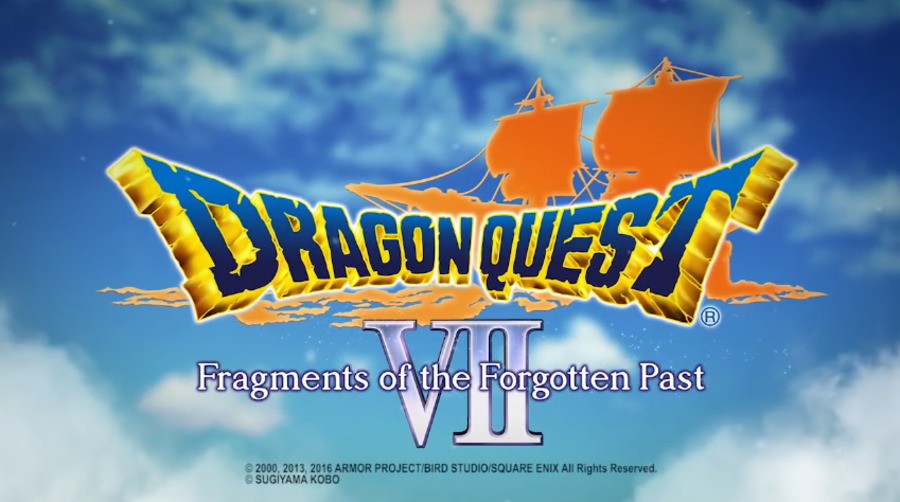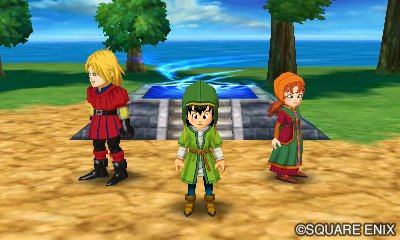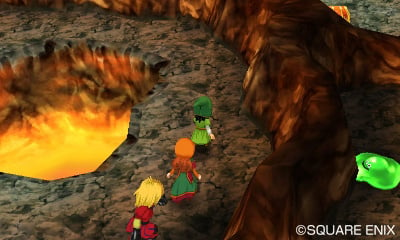
There are a small group of titles coming to the 3DS in 2016 that will target a broad audience, but one Summer release in particular has engaged a dedicated group of RPG fans - Dragon Quest VII: Fragments of the Forgotten Past. The wait for localisation certainly made some rather unhappy, especially in Europe where the PS1 original never arrived, but it's now getting closer to making its mark.
We learned a little more about it and enjoyed around 40 minutes of hands-on time during a recent visit to Nintendo UK's HQ, and it became clear why it's so eagerly anticipated. It's true that this writer is no expert on the series - fear not, we'll bring one on board when the time comes for a review - but it's nevertheless easy to appreciate why it's on so many wishlists.
We were first shown the game in a presentation, and it's immediately clear that it'll be a title to engross fans for weeks and months, certainly until Dragon Quest VIII: Journey of the Cursed King comes around. The original on PS1 was an interesting case - known as Dragon Warrior VII: Warriors of Eden in North America - due to the fact it was the first time that the development team had worked with the freedom of CD-ROM storage. Rather than produce enhanced visuals and step up the game in a new generation, the developers opted to cram more content onto the disc using older 2D-style visuals. The result is a monstrous game that can be pegged at around 120 hours from start to finish. That's hardcore, by any standards.

It's a big game, then, and Nintendo is evidently keen to help the Square Enix title succeed in the West, partly due to an extended hope - presumably - that success will encourage more localised releases in generations to come. Considering this 3DS release landed in Japan back in 2013, too, we know that it's a title that's had plenty of time for polish.
When seeing the game in action it certainly stands up well - it's a title that's been reimagined with a 3D engine, including the ability to pan the camera left and right with the L and R buttons. The world itself looks rather attractive by 3DS standards, albeit they're not representative of a top-of-class effort on the portable. As a remaster it's obviously limited by source material, and the focus has clearly been on solid performance above visual glitz; in this case that's a good choice. Despite obvious pop-in and basic textures, it runs smoothly and also looks charming with the 3D effect enabled on the top screen, a feature we've learned can't be taken entirely for granted.
Actually going hands on we were put into a save that was part of the way through what is typically considered as Chapter 2 - this seemed to be the spot chosen as it was relatively light on dialogue and had plenty of exploration and battling, while still being early enough in the game to have forgiving difficulty. Having spoken to disaffected villagers in 'Ballymolloy', which we think is supposed to be Scottish but doesn't quite pull off the dialect, we headed to a tower in the East to defeat a boss and return abducted women and girls to the village. This is early on in the game, but as a sense of the scope of the title it was already preceded by a surprising number of entries in the handy 'story so far' menu that serves as a text-based recap.

The gameplay, when tackled at its simplest level without diving off into menus, has a conventional but enjoyable RPG hook. Unlike in the original release, enemies are now visible on the map as you explore, meaning we enjoyed the option of easy battles to level up or dashing past to objectives; guidance is also minimal. In fact we even spent about five minutes getting slightly lost in the tower, which featured a series of stairways that seemed to have no end, but it was undeniably enjoyable to simply explore and loot treasure chests while wondering where the heck the Boss could be located.
Initiating battles kicks off conventional turn-based fare, too, albeit with Dragon Quest's style at play along with full visibility of you and your allies on the battlefield. You can attack, use offensive / defensive / special magic, help and buff teammates and also set their tactics. In easy battles we simply encouraged all-out attack from our buddies, but in a slightly tougher late encounter we set them to 'watch my back' or 'focus on healing', and in general they did as we asked. Once more abilities and styles become available it's evident that battles will be interesting affairs.
In some respects, such as exploration and battles, Dragon Quest VII can feel like a new and ambitious 3DS game to newcomers like this writer, with decent visuals and strong design. Yet with the new is the old, and some aspects of the presentation feel rather retro, for better and worse. The overall UI (user interface) is certainly simplistic on the eye, with plain boxes and grids of text, albeit it's effective in communicating key details. As is expected with a game of this depth there are a lot of sub-menus, items, skills and more to deal with, and they're presented relatively crisply here. Yet there's also no getting away from the fact it's also rather bare-bones stylistically, almost over-formal in its look, lacking the flair and flourishes that can perhaps be expected.

In truth, complaints about the UI and menus being boxy and having boring font is hardly going to dampen enthusiasm for this one, and nor should it. Retro aspects are also a positive, too - playing with headphones we certainly got drawn in by the MIDI music, and switching rooms or areas also triggers a delicious Bit-based sound effect. Even if you're unfamiliar with the history and reverence that this franchise commands, this game does a great job of helping you appreciate that legacy through its subtle nods and winks.
Pleasingly, this is also a re-imagining that makes decent use of the 3DS hardware's capabilities. We've already mentioned the pleasing autostereoscopic 3D, but it's also nice to see the bottom screen used for a dynamic map and to display party details such as their health and ability meters. A feature that was mentioned as a potential treat is StreetPass, too, with hits that'll include access to more dungeons to tackle. Beyond that the experience can be customised in menus, such as options to speed up battle animations and adjust the overall 3D depth that's allowed on the top screen.
Based on our short time with Dragon Quest VII: Fragments of the Forgotten Past the impression is that this won't disappoint the eager gamers clamouring for its release. It's a smart overhaul of the source material that also employs a nice blend of old and new features. For those that want a lengthy, dramatic RPG adventure that features time-travel and many hours of gameplay, it'll be hard to look beyond this one.





Comments 29
Guess I'll take a week or two off work for this one!
now we just need DQ1, 2 and 3 to get a 3DS release (and yes i know that they are on mobile but the touch screen controls are HORRIBLE), and RPG like Dragon Quest NEEDS to have proper button controls
Can't wait for this game! I absolutely loved the remakes of 4, 5 and 6 and the original 9 on the DS and 8 on the PS2! That main theme gives me EVERYTHING
Can not wait for this! Preordered and everything.
I'm new to the DQ series and playing through DQIV on my 3ds atm and I love what I'm playing so far. Kinda like Earthbound a bit.
This one or part VIII which one should I pick?
Ugh, I'd pick it up if it was still 2D.
@khululy Both! 8 was awesome on PS2 back in the day.
Looking forward too this .
@Bakajin Why does that matter?
Can't wait! Sounds like it fixes the few complaints I had with the original.
@The_Ninja Because the original PS1 game looked great, and this one doesn't. I like my 2D sprites.
Woop definitely going to try to preorder since this comes out day after my birthday. Is there going to be any special edition I wonder?
Can't wait to play this game!
Day 1 for me. Can't wait for this game to release in Europe !!
Honestly this is the game that should had arrived on Nintendo's system from the get-go. I remember both Dragon Quest VII and Final Fantasy VII were planned to be launch titles for Nintendo's 64DD add-on for the N64, it's too bad the 64DD failed and both games got released on PlayStation but at least Nintendo got Dragon Quest VII back. Can't wait to play it again even though I got Dragon Warrior VII already.
I'm in the Dragon Quest mood, been playing the heck out of the original VIII PS2 version recently!
About time North Americans get some Dragon Quest love! Can't wait for this game,will be getting it day one when it comes out. Will be great until VIII comes out
You wouldn't believe how eager I am to finally be able to play DQ7... it's a game I've been longing to play ever since it was released late on PS1 and didn't get a Europe release. ;-; ...HYPE! Ahm, sorry about that, this is such an instant purchase for me. :3
I really am very excited for this game. Gotta play 6 first. Hope we get a release date for 8 fairly soon, and some DQ 11 info.
I have been waiting so long for this game. It is the only one I don't have/played besides DQ10. The game is going to rule my life. It is not a summer release though. I thought it was going to be out in September.
i can't wait to play this. I'm honestly really looking forward to this game. I've only played 9 but I loved it.
How about that Wii boxed set we never got?
I've played 4 & 5 on my tablet, and they were absolutely fantastic games.
I may make this my priority 3DS purchase for the year.
So, I presume this gigantic duration (the 120hours) is maintained in the 3DS version? No matter what, it's a Dragon Quest, so I need to add it to my DS collection.
@Bakajin I was a bit disappointed back then when it was announced in japan. At first I expected the graphics to be something like a enhanced version of the 2D/3D mix used in the DS "trilogy".
Now, if we could get Draque X client before the game sinks in Japan. I would gladly pay my first subscription to an online game if it was for this title. I forced the download of the japanese client, but it seems they have some connection check (or I would already have bought a month of play).
I am intrigued by the XI too. I know it won't be the "real" game was it was thought initially (like the versions for house consoles) but I am very interested to see what they will propose for this kind of 3DS exclusivity (it's clear both pocket and house games are not the same).
Square Enix's reluctance to release the 3DS remakes of DQ7&8 outside Japan has been rather irksome - 3DS owners have had zero DQ this handheld cycle whereas we had 4 main games and at least 3 spinoffs between the Joker series and Rocket Slime (unless I'm forgetting more). The DS had at least 7 DQ games and the 3DS has had none. And I'm surprised we're even getting them because I remember about 2-3 years ago, Square backtracked and mentioned they weren't sure if they were going to still release them stateside or overseas. I suppose getting them later - a lot later - is better than nothing. C'mon, man: I haven't heard the awesome DQ opening theme on the 3DS! I love that theme! Can't wait for this one or DQ8: those are day one preorders for me as soon as they go live!
@JaxonH
Explain yourself. I want in on this.
Can't wait for this to come out, also when DQ 8 hits the shelves, I won't be putting my N3DS down anytime soon.
So, I'm SINCERELY annoyed by the trailer and the reviewers comment about the music for the following reason:
I've been playing the Japanese 3DS version for three years, now, and their cartridge has the fully orchestrated soundtrack; from the trailer, I'm HOPING that the Western version includes that, as well.
UGH. Freakin' MIDI, again.
@Captain_Gonru or a 3 in 1 3 DS release
Tap here to load 29 comments
Leave A Comment
Hold on there, you need to login to post a comment...